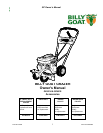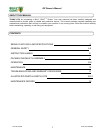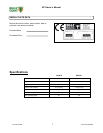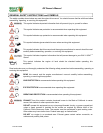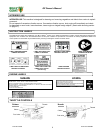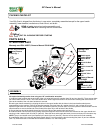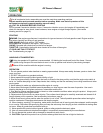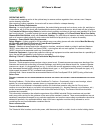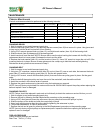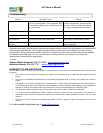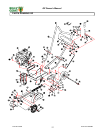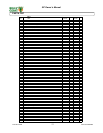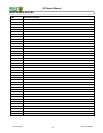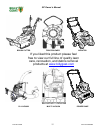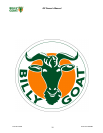
Part No 610428 Form No F022508A
9
GZ Owner’s Manual
OPERATING HINTS:
A side-to-side sweeping motion is the quickest way to remove surface vegetation from crevices, even if deeper
crevice cleaning is desired.
After removing surface vegetation, the crevice will be more visible for a deeper cleaning.
Power Brush Safety Requirements
Warning – In normal power brushing operations, the material being removed such as burrs, scale, dirt, weld slat, or
other residue, will fly off the brush with considerable force along with brush filaments, which break off due to fatigue.
The Potential of Serious Injury Exists for both the brush operator and others in the work area (possible 50 or more
feet from the brush). To protect against this hazard, wear Safety Goggles or Full Face Shields Worn Over Safety
Glasses With Side Shields, along with Protective Clothing. You must follow all operator and safety instructions, as
well as all common safety practices, which reduce the likelihood of physical injury, or reduce its severity.
Summary – Power Brush Safety Requirements
Safety Goggles – Safety goggles or full face shields worn over safety glasses with side shields Must Be Worn by
all Operators and Others in the Area of Power Brush Operations.
Guards – Keep all machine guards in place.
Speeds – Observe all speed restrictions indicated on brushes, containers, labels or printed in pertinent literature.
“MSFS” means Maximum Safe Free Speed (RPM) – spinning free with no work applied. For reasons of safety,
“MSFS” should not be exceeded under any circumstances.
Protective Equipment – Appropriate protective clothing and equipment must be used where there is a possibility of
injury that can be prevented by such clothing or equipment.
Warning! Failure To Observe Safety Precautions May Result In Injury.
Brush usage Recommendations
Pressure – Avoid excessive pressure when using a power brush. Excessive pressure causes over-bending of the
filaments and heat build-up resulting in filament breakage, rapid dulling and reduced brush life. Instead of greater
pressure on a brush, it is suggested that you try: 1) a brush with a more aggressive cutting action (increased wire
size, decreased filament length, change to a different brush type, i.e., knot type instead of crimped wire type), or 2)
higher speed (increased R.P.M., increased brush diameter.)
Important Note: Never exceed the recommended Maximum Safe Free Speed R.P.M. (MSFS) rating of the brush.
S
AFETY FIRST
F
AILURE TO OBSERVE ANY OF THE REQUIREMENTS SHOWN IN THE SAFETY SECTION WILL CREATE HAZARDS AND CAN CAUSE
INJURY
.
Brushing Problems – Do Not Allow unsafe Conditions To Continue. Occasionally, due to worn bearings, a bent
spindle, an unusual application, operator abuse, or inappropriate use, a brush may fail.
A brush which is not received in acceptable condition for trouble-free operation may also fail. Do not use or
continue to use a failed brush or one which is functioning improperly (i.e., throwing filaments, out-of-balance, etc.)
as this increases the possibility for further brush failure and hazard of injury. The cause of the failure should be
evaluated and corrected.
This information is based on the collective experience of the ABMA Industrial Division members and provided
solely as a public service for the guidance of the users of the members’ products. These recommendations are not
necessarily complete with respect to any particular application and common sense safety considerations should be
adhered to generally. Any applicable federal, state, local law or regulation must be strictly adhered to, and is
controlling over any recommendation contained herein.
SAFETY INSTRUCTIONS
T
WISTED-IN-WIRE BRUSHES
The Twisted-In-Wire brushes
,
used under
p
ower
,
shall be securel
y
held in a collet
,
chuck or similar holdin
g
device.



